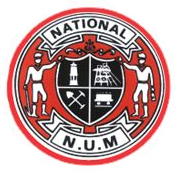
The National Union of Mineworkers (NUM) is a trade union for coal miners in Great Britain, formed in 1945 from the Miners' Federation of Great Britain (MFGB). The NUM took part in three national miners' strikes, in 1972, 1974 and 1984–85. After the 1984–85 strike and the subsequent closure of most of Britain's coal mines, it became a much smaller union. It had around 170,000 members when Arthur Scargill became leader in 1981, a figure which had fallen in 2015 to an active membership of around 100.
The Miners' Federation of Great Britain (MFGB) was established after a meeting of local mining trade unions in Newport, Wales in 1888. The federation was formed to represent and co-ordinate the affairs of local and regional miners' unions in England, Scotland and Wales whose associations remained largely autonomous. At its peak, the federation represented nearly one million workers. It was reorganised into the National Union of Mineworkers in 1945.

The South Wales Miners' Federation (SWMF), nicknamed "The Fed", was a trade union for coal miners in South Wales. It survives as the South Wales Area of the National Union of Mineworkers.

The National Union of Scottish Mineworkers (NUSW) is a trade union in Scotland, founded in 1894 as the Scottish Miners Federation. It joined the Miners' Federation of Great Britain, and in 1914 changed its name to National Union of Scottish Mineworkers. It survives as the National Union of Mineworkers.
The National Union of Blastfurnacemen, Ore Miners, Coke Workers and Kindred Trades (NUB) was a trade union in England and Wales which existed between 1888 and 1985. It represented process workers in the British iron and steel industry.
The Lancashire and Cheshire Miners' Federation (LCMF) was a trade union that operated on the Lancashire Coalfield in North West England from 1881 until it became the Lancashire area of the National Union of Mineworkers in 1945.

The Nottinghamshire Miners' Association was a trade union representing coal miners in Nottinghamshire, in England.
The Midland Counties Miners' Federation was a trade union, representing coal miners in the West Midlands region of England.
The North Wales Miners' Association was a trade union representing coal miners in Wales.
The Fife and Kinross Miners' Association was a coal miners' trade union based in Fife and Kinross-shire in Scotland.
Samuel Henry Whitehouse was a British trade unionist.
The Bristol Miners' Association was a trade union representing coal miners in Bristol and Bedminster in England.
The Forest of Dean Miners' Association was a trade union for coal miners in the Forest of Dean area of England.
The Stirling Miners County Union was a trade union representing coal miners in the Stirlingshire area of Scotland.
The Cleveland Miners' and Quarrymen's Association was a trade union representing ironstone miners in the Cleveland area of England.
The Cannock Chase Miners', Enginemen's and Surfacemen's Association was a trade union representing coal miners in the Cannock Chase area of England.
The North Staffordshire Miners' Federation was a trade union representing miners in the area of Stoke-on-Trent, located in Staffordshire, in England.
The West Bromwich Miners' Association was a trade union representing coal miners in southern Staffordshire and eastern Worcestershire, in the United Kingdom.
The Monmouthshire and South Wales Miners' Association was a trade union representing coal miners in south eastern Wales.
The Ebbw Vale and Sirhowy Colliery Workmen's Association was a trade union representing coal miners in the Ebbw Vale area of South Wales.




